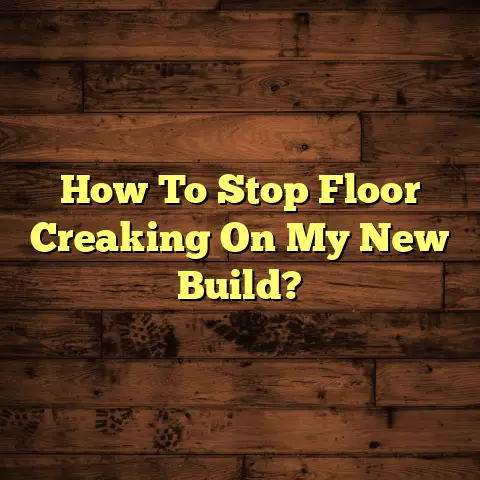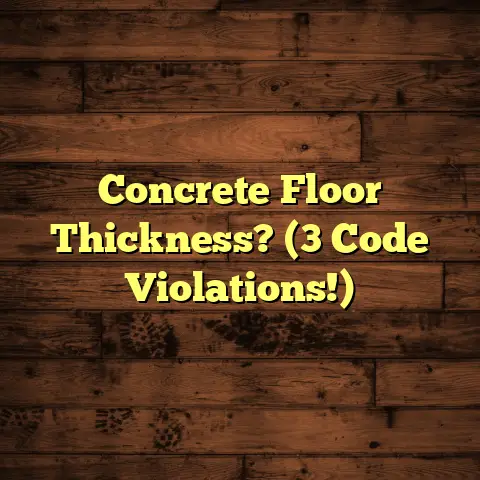How Much Does Flooring Cost For 2000 Sq Ft House (Explained)
When it comes to flooring, hardwood is often regarded as one of the most desirable options.
It not only adds warmth and beauty to a home but also offers durability and longevity.
However, before diving into a hardwood flooring project, it’s essential to understand the various costs involved—especially for a sizable area like a 2000 sq ft house.
This article breaks down the major factors affecting hardwood flooring installation costs, provides detailed price ranges, compares hardwood with other flooring types, and offers valuable insights into maintenance and care.
Major Cost Factors
1. Area Size
The total square footage of your home directly impacts the overall cost of hardwood flooring installation.
Larger areas will naturally require more materials and may increase labor costs, while smaller areas might have higher per-square-foot rates due to setup and transportation.
2. Hardwood Type
Different types of hardwood come with varying price tags. Common species include:
- Oak: Generally ranges from $3 to $8 per sq ft.
- Maple: Typically costs between $4 and $10 per sq ft.
- Cherry: Usually priced around $5 to $12 per sq ft.
- Walnut: Often ranges from $8 to $15 per sq ft.
- Engineered Wood: Costs can vary from $2 to $12 per sq ft depending on quality and brand.
3. Labor Costs
Labor rates can differ significantly based on location and the complexity of the installation.
On average, you can expect to pay between $2 to $6 per sq ft for professional installation.
Special patterns like herringbone or intricate designs may incur higher costs.
4. Additional Considerations
Several other factors can impact the total cost:
- Floor Removal: If you need to remove old flooring, this could add an additional $1 to $3 per sq ft.
- Subfloor Replacement: Any repairs or replacement of the subfloor can lead to increased costs, depending on the extent of damage.
- Material Grade: Higher-grade wood typically costs more but offers better durability and aesthetics.
- Room Size/Layout: Unusual room shapes may require additional cuts and adjustments, increasing labor time.
- Installation Type: Nail-down, glue-down, or floating installations each have different costs associated with them.
Cost Breakdown
For a 2000 sq ft house, here’s a rough estimate of costs based on different hardwood types:
Hardwood vs Alternative Flooring Options
When considering flooring options, it’s essential to compare hardwood with alternatives like laminate, vinyl, and carpet:
- Laminate: Costs range from $1 to $5 per sq ft.
While laminate can mimic hardwood’s appearance, it lacks the same durability and resale value. - Vinyl: Typically priced between $1 to $4 per sq ft.
Vinyl is water-resistant and budget-friendly but does not offer the same aesthetic appeal as hardwood. - Carpet: Costs usually range from $2 to $7 per sq ft.
Carpet provides comfort but requires more maintenance and has a shorter lifespan compared to hardwood.
Quick Comparison Table
Signs That Hardwood Floors Need Replacement
While hardwood floors can last for decades if properly maintained, there are signs that indicate it may be time for replacement:
- Deep Scratches and Gouges: If the damage is too extensive for refinishing.
- Warping or Buckling: Often caused by moisture issues.
- Severe Discoloration: Aged or sun-damaged wood that cannot be restored.
- Squeaking or Creaking: Indicates structural issues that may require replacement.
Refinishing vs Replacement
Deciding whether to refinish or replace your hardwood floors depends on their condition:
- Refinishing is ideal for floors with minor scratches and wear.
It costs less (around $1.50 to $5 per sq ft) compared to replacing and can restore the floor’s original beauty. - Replacement is necessary for severely damaged or outdated floors.
It is more expensive but offers a chance to upgrade wood type or style.
Pros and Cons of Hardwood Flooring
Pros
- Aesthetic Appeal: Offers timeless beauty and adds value to your home.
- Durability: With proper care, hardwood floors can last a lifetime.
- Versatility: Available in various styles and finishes that complement any décor.
- Sustainability: If sourced sustainably, hardwood is an eco-friendly option.
Cons
- Cost: Higher initial investment compared to other flooring types.
- Maintenance: Requires regular care to keep it looking its best.
- Susceptibility to Water Damage: Not ideal for areas prone to moisture unless treated properly.
Professional Installation vs DIY
Choosing between professional installation and DIY can significantly affect your overall costs.
Here’s a breakdown:
Professional Installation
- Costs: Approximately $2-$6 per sq ft for labor.
- Benefits:
- Expertise ensures proper installation.
- Saves time and effort.
- Reduces the risk of mistakes that could lead to costly repairs.
DIY Installation
- Costs: Savings on labor can reduce total expenses.
- Considerations:
- Requires skills and knowledge of installation techniques.
- Necessary tools (saw, nail gun) may add up in cost if not already owned.
- Risk of improper installation leading to potential issues down the line.
Questions to Ask Hardwood Flooring Contractors
When hiring a contractor, consider asking the following questions:
- What is included in your estimate?
- Are you licensed and insured?
- How long will the installation take?
- What types of wood do you recommend for my project?
- Can you provide references from past clients?
- What warranty do you offer on materials and labor?
- How do you handle unexpected complications during the project?
Hardwood Floor Care and Maintenance Tips
To maximize the longevity of your hardwood floors, follow these maintenance tips:
- Regular Cleaning: Sweep or vacuum frequently to remove dirt and debris.
- Use Proper Cleaners: Avoid harsh chemicals; use products specifically designed for hardwood floors.
- Humidity Control: Maintain indoor humidity levels between 30% and 50% to prevent warping.
- Area Rugs: Place rugs in high-traffic areas to protect against scratches.
- Protective Pads: Use felt pads under furniture legs to avoid damage.
Conclusion
Installing hardwood flooring in a 2000 sq ft house involves various cost factors that need careful consideration.
From material choice to installation methods, understanding these elements can help you make informed decisions that align with your budget and aesthetic preferences.
By weighing the pros and cons of hardwood against other flooring options and considering maintenance needs, you can ensure that your investment pays off in beauty and durability for years to come.
Whether opting for professional installation or taking on the project yourself, always keep in mind the long-term benefits that well-maintained hardwood floors can offer your home.





